I was recently gifted an unwanted 2008 Genesis E-310 NG (model #93841001). I've been reading lots of old threads here for rehab and converting to LP, and you guys are rockstars - I've learned a lot already. I just wanted to post some starting pictures of the grill and get some advice on components and cleaning tips you'd recommend. This is my first real grill and I'm excited, but want to make sure I treat it right.
Here are some starting pictures:
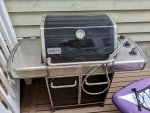

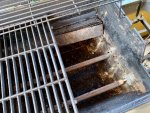
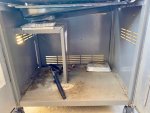
I understand the distinction between fixed and continuous valves (thanks, LMichaels!), and confirmed I lucked out with continuous valve spools:
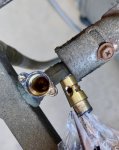
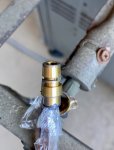
But I'm still on the fence between buying LP orifices + regulator ($46 landed, grill-repair.com) or a full LP manifold ($117 landed, grillparts.com) because:
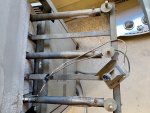
With all that, I was hoping to get input on 5 questions:
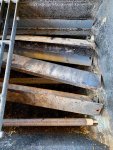
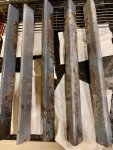
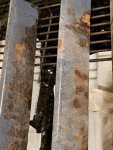
And just for laughs, this little amputated Char-Broil is what I've been grilling with the last couple of years. Its lone flavorizer bar looks like a bunch of corn flakes at this point but it's got character. Can't wait to get the Weber fired up.
Here are some starting pictures:




I understand the distinction between fixed and continuous valves (thanks, LMichaels!), and confirmed I lucked out with continuous valve spools:


But I'm still on the fence between buying LP orifices + regulator ($46 landed, grill-repair.com) or a full LP manifold ($117 landed, grillparts.com) because:
- I know with fixed valves, aperture size is different between NG (larger opening) and LP (smaller opening). For those who have converted before - is it confirmed that NG/LP continuous valves are identical, and an orifice swap to LP will give me the same performance? I can imagine a hypothetical world where NG continuous valves have a wider graduated slot than LP continuous valves, leading to hotter burns at lower settings with LP fuel.
- With no NG hookup at my building I can't do a test-fire. How does this manifold and burner wear look to a trained eye? From what I can tell, the grill has never really been cleaned. The person who gifted it to me also never fired it up; it was included with a home they bought.

With all that, I was hoping to get input on 5 questions:
1. Given the state of the manifold, would you guys go for the full manifold swap or just switch out orifices/regulator?
2. I was wondering about the LP tank scale (~$30). I know they're not strictly necessary. Anyone think it's worth the price (and know what the mounting screw dimensions are? aftermarket scales don't include the hardware to mount the scale to the frame)
3. Hose length - I can get 28" or 40", and planning to get 28" unless there are strong objections.
4. Any tips for cleaning the real caked-on stuff inside? I've been scraping away at the burn box, but the drip tray is in dire straits. Not sure if the original owners even emptied it once...when I picked up the grill there was so much built-up debris in the tray that a huge colony of nasty looking bugs had taken up residence inside.
5. Finally, I was wondering about the state of these porcelain enameled flavorizer bars. I scrubbed them for a while with dish soap and steel wool (hope that wasn't a terrible idea...) Most of the char is off but there's definitely rust and cavitation on these things. I'm hoping they still have some life left in them.



And just for laughs, this little amputated Char-Broil is what I've been grilling with the last couple of years. Its lone flavorizer bar looks like a bunch of corn flakes at this point but it's got character. Can't wait to get the Weber fired up.
Last edited:
